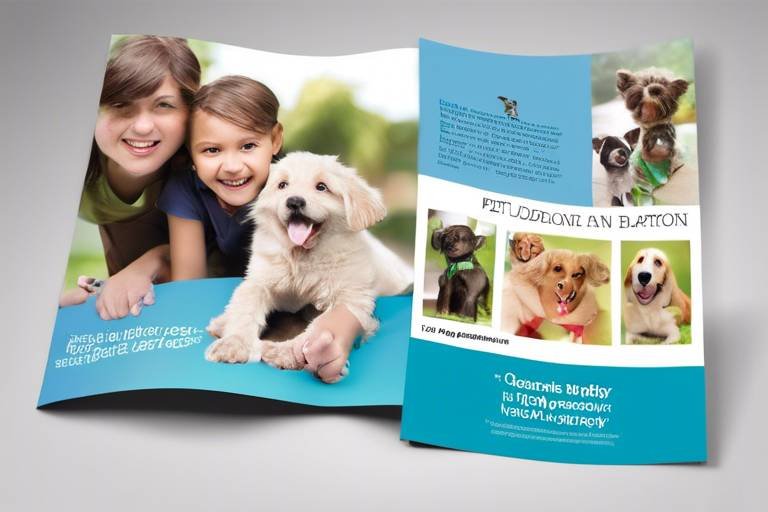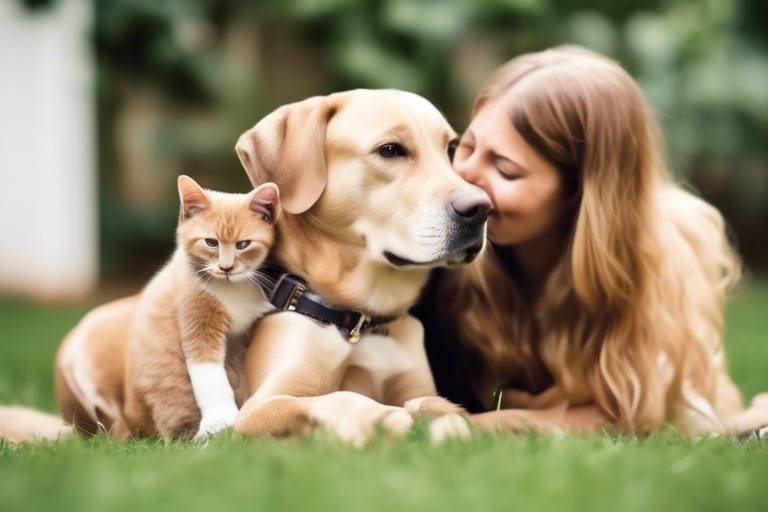How to Make Your Shelter More Adoption-Friendly
This article explores effective strategies to enhance the adoption experience in animal shelters, focusing on creating a welcoming environment, improving animal visibility, and fostering community engagement to increase successful adoptions.
A friendly atmosphere is vital for potential adopters. Imagine walking into a place that feels like home, filled with warmth and smiles. This is the kind of environment that animal shelters should strive to create. By designing a space that encourages interaction, shelters can significantly enhance the adoption experience. Start by ensuring that the shelter is clean, well-lit, and decorated with cheerful colors. Use comfortable seating areas where visitors can relax and interact with animals. Additionally, having friendly staff members available to answer questions and provide information can make all the difference. When visitors feel at ease, they are more likely to spend time with the animals and consider adoption.
Visibility plays a crucial role in adoption rates. Picture this: a potential adopter walks into a shelter and is immediately drawn to a vibrant display of animals, each with their own unique personality shining through. To achieve this, shelters can implement various methods to effectively showcase their animals. For instance, using clear signage that highlights each animal's name, age, and personality traits can help visitors connect with them on a personal level. Additionally, creating a dedicated adoption area where animals can be seen playing or interacting can capture the attention of passersby.
Social media platforms are powerful tools for promoting adoptable pets. In today’s digital age, engaging content can reach thousands of potential adopters with just a few clicks. By sharing heartwarming stories, photos, and videos of animals, shelters can create a strong online presence. It's not just about posting; it’s about connecting. Use platforms like Instagram and Facebook to showcase animals in action, share their journeys, and highlight the joy they can bring to a home.
Crafting compelling posts can attract more followers and potential adopters. Think of your posts as little invitations to potential adopters. Use high-quality images that capture the essence of each animal. Write captivating captions that tell a story or share fun facts about the pet's personality. For example, instead of saying "Meet Max, a friendly dog," you could say, "Max is a playful pup who loves belly rubs and chasing after tennis balls! He’s ready to be your new best friend!" This approach not only showcases the animal but also creates an emotional connection.
Virtual events allow shelters to reach a wider audience. Imagine being able to meet your future furry friend without leaving your couch! Hosting online adoption fairs can enable potential adopters to meet animals from the comfort of their homes. Use video conferencing tools to showcase animals live, allowing viewers to see their personalities and ask questions in real-time. This innovative approach can significantly increase adoption rates, especially for those who may not be able to visit the shelter in person.
Enrichment activities enhance animals' well-being and make them more appealing to adopters. Just like humans, animals thrive when their environment is stimulating and engaging. Implementing various enrichment techniques, such as interactive toys, social playtime, and training sessions, can improve animals' behavior and overall presentation in the shelter. When animals are happy and well-adjusted, they are more likely to attract potential adopters. Consider creating a daily schedule of enrichment activities that staff and volunteers can follow to ensure that every animal receives the attention they deserve.
Building strong community ties is essential for a successful shelter. A shelter that is actively involved in its local community can create a supportive network that encourages adoption and volunteerism. Engage with local residents and businesses by hosting events, workshops, and outreach programs. When the community feels connected to the shelter, they are more likely to support its mission and consider adopting a pet.
Community events can raise awareness about the shelter and its animals. Think about organizing fun, engaging activities like pet parades, adoption fairs, or educational workshops on responsible pet ownership. These events not only draw people to the shelter but also foster connections between the shelter and the local community. When people see the joy that pets bring, they are more likely to consider adoption.
Collaborating with local businesses can enhance visibility and resources for the shelter. By forming partnerships, shelters can benefit from sponsorships, donations, and increased foot traffic during adoption events. For instance, a local pet store might host an adoption day at their location, allowing animals to be showcased in a different environment. These collaborations not only help the shelter but also promote local businesses, creating a win-win situation.
- How can I volunteer at my local shelter? Most shelters have volunteer programs. Check their website or contact them directly for more information.
- What should I consider before adopting a pet? Consider your lifestyle, living situation, and the time you can dedicate to a pet. It's essential to choose an animal that fits your family and lifestyle.
- How can I help promote adoptions? Share posts from your local shelter on social media, attend events, and encourage friends and family to consider adoption.

Creating a Welcoming Environment
Creating a welcoming environment in your animal shelter is akin to setting the stage for a heartwarming play where every actor, or in this case, every animal, has a chance to shine. Imagine walking into a space that feels warm, friendly, and inviting. This atmosphere is crucial for potential adopters who might be feeling a mix of excitement and apprehension. The first step in making your shelter more adoption-friendly is to ensure that visitors feel at home. This can be achieved through thoughtful design and strategic layout.
Start by considering the layout of your shelter. Is it easy for visitors to navigate? A well-organized space not only enhances the experience but also encourages people to explore. Use bright colors and comfortable seating areas where potential adopters can relax and engage with the animals. Incorporating natural elements, such as plants and artwork featuring animals, can create a more inviting atmosphere. Think of it as creating a cozy living room where people feel comfortable and at ease.
Another vital aspect is the interaction between the staff and the visitors. Staff members should be trained to greet guests with enthusiasm and warmth, making them feel welcome as soon as they step through the door. A friendly smile and a genuine conversation can break the ice and make potential adopters more likely to engage with the animals. Consider implementing a "meet and greet" area where visitors can spend time with animals in a relaxed setting. This not only helps in building a bond but also allows visitors to see the animals' true personalities.
Additionally, consider hosting regular open house events. These occasions can transform your shelter into a community hub, where people can come together to learn about the animals and the importance of adoption. Think of it as a community picnic where everyone is invited to bring their families and friends. Include activities like face painting for kids, food trucks, and even local musicians to create a festive atmosphere. This approach not only draws in potential adopters but also fosters a sense of community support.
Finally, don't underestimate the power of signage. Clear, friendly signs can guide visitors through the shelter while providing information about each animal’s story and personality. Use engaging language and photos that capture the essence of each pet. Remember, these signs should tell a story, inviting visitors to connect emotionally with the animals. A well-placed sign can be the difference between a passerby and a potential adopter.
In summary, creating a welcoming environment in an animal shelter involves a combination of thoughtful design, enthusiastic staff interaction, community engagement, and effective communication. By focusing on these elements, you can significantly enhance the adoption experience, making it easier for people to open their hearts and homes to animals in need.

Enhancing Animal Visibility
When it comes to finding forever homes for our furry friends, visibility is everything. Imagine walking into a shelter where the animals are not only seen but also celebrated. It’s crucial to create an environment that showcases each pet’s unique personality and charm. By enhancing animal visibility, shelters can significantly increase their chances of successful adoptions. So, how can we make our beloved animals stand out? Let’s dive into some effective strategies!
First and foremost, consider the layout of your shelter. Animals should be easily accessible and visible to visitors. This means avoiding crowded cages and ensuring that each pet has enough space to display their personality. A well-organized area where animals can roam freely or interact with potential adopters can make a world of difference. You might think of it like a gallery where each animal is a piece of art waiting to be appreciated!
Another powerful method to enhance visibility is through creative signage. Bright, welcoming signs can guide visitors through the shelter while providing information about each animal. Think about using colorful banners that highlight special traits or stories of the pets. For example, a sign that reads, "Meet Bella: The Cuddliest Companion You’ll Ever Find!" can catch attention and spark interest. Don't forget to include fun facts about each animal, which can serve as conversation starters for visitors.
In addition to physical visibility, we can't overlook the impact of technology. Utilizing social media platforms is a game-changer for shelters looking to showcase their animals. Imagine posting a heartwarming video of a dog playing fetch or a cat snuggling with a volunteer. These engaging posts can capture the hearts of potential adopters who might not even set foot in the shelter. It's like giving a sneak peek into the lives of these animals, allowing their personalities to shine through.
Social media is not just a trend; it's a powerful tool for promoting adoptable pets. By creating engaging content, shelters can share the stories of their animals with a broader audience. Here are some strategies to consider:
- High-Quality Images: Always use clear, high-resolution images that show the animals in their best light. A picture is worth a thousand words, and a captivating image can make all the difference in grabbing attention.
- Storytelling: Share the backstories of the animals. People love to connect emotionally, so detailing how a pet arrived at the shelter or their favorite activities can resonate with potential adopters.
- Hashtags: Use relevant hashtags to increase visibility. Tags like #AdoptDontShop or #ShelterPets can help reach a larger audience.
Crafting compelling posts is essential for attracting followers and potential adopters. Here are some tips for writing captivating captions:
- Be Personable: Use a friendly and approachable tone. Instead of saying, "This is Max," try, "Meet Max, your future best friend!"
- Ask Questions: Engage your audience by asking questions in your posts. For instance, "What do you think Max’s favorite toy is?" This invites interaction and keeps your followers engaged.
- Call to Action: Encourage your audience to share posts or visit the shelter. For example, "Come meet Max this weekend and see if he’s the one for you!"
In today’s digital age, virtual adoption events are a fantastic way to enhance visibility. These events allow shelters to reach a wider audience, enabling potential adopters to meet animals from the comfort of their homes. Imagine hosting a live stream where viewers can interact with animals in real-time, ask questions, and even fill out adoption applications online. It’s like a virtual pet fair that breaks down geographical barriers!
To successfully host a virtual adoption event, you’ll need a solid plan. First, choose a platform that allows for live interaction, such as Facebook Live or Zoom. Promote the event well in advance to build anticipation. During the event, showcase different animals, share their stories, and encourage viewers to ask questions. This interactive experience can create a personal connection, making it more likely that someone will choose to adopt.
By implementing these strategies to enhance animal visibility, shelters can create an inviting atmosphere that encourages potential adopters to connect with their future pets. Remember, every little effort counts when it comes to finding loving homes for these adorable companions!
Q: How can I help improve visibility for my local shelter?
A: You can volunteer your time, share posts on social media, or even foster animals to help them gain exposure.
Q: What types of content work best on social media for shelters?
A: Engaging stories, high-quality images, and videos showcasing the animals’ personalities tend to perform best.
Q: Are virtual adoption events effective?
A: Yes! They allow shelters to reach a broader audience and provide a unique way for potential adopters to interact with animals.
Utilizing Social Media
In today's digital age, social media is not just a platform for sharing selfies and memes; it's a powerful tool for animal shelters to connect with potential adopters. Imagine scrolling through your feed and stumbling upon an adorable puppy or a charming cat that instantly tugs at your heartstrings. That’s the magic of social media! By effectively utilizing these platforms, shelters can showcase their adoptable pets and share their unique stories, making it easier for people to fall in love at first sight.
To make the most of social media, shelters should focus on creating engaging content that resonates with their audience. This means posting high-quality images and videos of the animals, capturing their personalities and quirks. A picture is worth a thousand words, and in the case of adoptable pets, it can be the difference between a passing glance and a lifelong commitment. For instance, instead of just a standard photo, how about a video of a playful dog chasing after a ball or a cat lounging in a sunbeam? These moments can create a connection that text alone simply can’t convey.
Moreover, storytelling is key. Every animal has a story, and sharing these narratives can significantly boost their chances of finding a forever home. For example, a post might read, "Meet Bella, a 3-year-old lab mix who loves belly rubs and has been waiting for her forever home for over six months. She dreams of a family who will take her on adventures and cuddle with her on rainy days." This not only highlights Bella's personality but also invites potential adopters to imagine her in their lives.
Engagement is another crucial aspect of social media. It's not enough to just post pictures; shelters should actively interact with their followers. Responding to comments, asking questions, and encouraging followers to share their own pet stories can create a sense of community. For instance, a post could ask, "What’s your favorite memory with your pet?" This kind of interaction not only builds relationships but also keeps the shelter at the forefront of people's minds when they consider adoption.
Additionally, shelters can leverage social media analytics to understand what content resonates most with their audience. By tracking engagement metrics such as likes, shares, and comments, shelters can refine their strategies to better connect with potential adopters. For example, if a particular post featuring a specific breed garners a lot of attention, it might be worth creating more content around that breed or similar ones.
Lastly, consider hosting online adoption events through social media platforms. These virtual gatherings can showcase multiple animals in one go, allowing potential adopters to "meet" them from the comfort of their homes. Think of it as a virtual open house where people can ask questions in real-time and see the animals in action. This approach not only broadens the reach but also makes the adoption process more accessible.
In summary, utilizing social media effectively can transform the way shelters connect with potential adopters. By creating engaging content, sharing stories, fostering community interaction, analyzing engagement metrics, and hosting virtual events, shelters can significantly increase their visibility and, ultimately, their adoption rates. So, grab your smartphone, get creative, and let those furry faces shine!
Creating Engaging Posts
When it comes to promoting adoptable pets, creating engaging posts is like crafting a love letter to potential adopters. You want your audience to feel the warmth and personality of each animal, making them irresistible. So, how do you do this? First, think about the power of storytelling. Each pet has a unique story that can tug at the heartstrings. Share their journey—where they came from, their quirks, and what makes them special. For instance, instead of just saying, “Meet Bella, a friendly dog,” try something like, “Meet Bella, a spirited 2-year-old who loves belly rubs and chasing her tail! She dreams of finding a family to share her adventures with.” By personalizing the narrative, you create a connection that can resonate with potential adopters.
Next, let’s talk about visuals. High-quality images are your best friends in this endeavor. A picture is worth a thousand words, right? Use bright, clear photos that capture the animal’s personality. Consider taking candid shots of them playing, cuddling, or showing off their silly side. You could even create a photo collage that highlights their daily activities—think of it as a day in the life of your shelter pet! This not only showcases their charm but also makes your posts visually appealing, drawing in more viewers.
But wait, there’s more! Captivating captions are crucial. Make them fun and engaging, and don’t shy away from using emojis to add a playful touch. For example, “🐾 Bella is ready to steal your heart! 💖 Come meet her today and see if she’s the one!” This kind of language invites interaction and encourages readers to share your posts. Remember, the goal is to create a community around your shelter’s animals, so the more engaging your content, the better!
To maximize your posts' reach, consider using hashtags relevant to your local community and animal adoption. This way, when someone searches for adoptable pets in your area, your posts pop up! Think about hashtags like #AdoptDontShop or #ShelterPetsOf[YourCity]. It's an easy way to connect with a broader audience and increase visibility.
Lastly, don’t forget to encourage sharing! At the end of your posts, add a gentle nudge, like, “Know someone looking for a furry friend? Share this post!” This simple call-to-action can significantly expand your reach and bring in potential adopters who may not have otherwise seen your posts.
In summary, creating engaging posts is all about storytelling, stunning visuals, playful captions, strategic hashtags, and encouraging shares. With these elements combined, your shelter’s social media can become a vibrant hub for animal lovers, fostering connections that lead to happy adoptions!
- How often should I post about adoptable pets? Aim for at least 3-5 times a week to keep your audience engaged and informed.
- What types of content work best on social media? A mix of photos, videos, stories, and engaging questions tends to perform well. Don’t forget to include posts about community events!
- Can I use user-generated content? Absolutely! Sharing posts from adopters showcasing their new pets can create a sense of community and inspire others to adopt.
Hosting Virtual Adoption Events
In today's digital age, has become a game-changer for animal shelters looking to connect with potential adopters. Imagine being able to showcase adorable pets from the comfort of your own home! Virtual events not only expand your reach but also create a relaxed environment where potential adopters can interact with animals without the pressure of an in-person visit. So, how do you make these events engaging and successful?
First and foremost, you need to choose the right platform. Whether it's Zoom, Facebook Live, or Instagram, the platform you select should be user-friendly and accessible for your audience. Once you've decided, it's time to plan the event! Consider creating a schedule that includes:
- Meet and Greet: Allow potential adopters to meet the animals virtually. Have a staff member or volunteer introduce each pet, sharing their unique stories and personalities.
- Q&A Sessions: Engage viewers by answering their questions in real-time. This interaction can significantly enhance their connection to the animals.
- Fun Activities: Incorporate games or contests that involve the audience, such as trivia about the animals or a photo contest for the best pet-related picture.
To promote your event, utilize your shelter's social media channels and email newsletters. Create eye-catching graphics and share sneak peeks of the animals that will be featured. The more buzz you generate, the more attendees you’ll attract!
Another crucial aspect is to ensure that the event runs smoothly. Test your technology beforehand to avoid any technical hiccups during the live session. Additionally, having a backup plan, such as a recorded video of the animals, can be a lifesaver in case of internet issues.
Finally, after the event, follow up with attendees. Send thank-you emails, provide additional information about the animals they showed interest in, and encourage them to schedule a visit to the shelter. This personal touch can make all the difference in converting interest into actual adoptions.
In conclusion, virtual adoption events are an innovative way to broaden your shelter's reach and connect with potential adopters in a meaningful way. By creating an engaging and interactive experience, you not only showcase the animals but also foster a sense of community, making it easier for people to find their perfect furry companion.
Here are some common questions regarding virtual adoption events:
| Question | Answer |
|---|---|
| How do I register for a virtual adoption event? | Registration details are usually posted on our social media channels and website. Click the link to sign up! |
| Can I adopt a pet during the virtual event? | Yes! If you find a pet you’re interested in, you can fill out an application during or after the event. |
| What if I have more questions after the event? | You can always reach out via email or phone; we’re here to help! |
Improving Animal Enrichment
When it comes to making animals more appealing to potential adopters, enrichment is the name of the game. Imagine walking into a shelter where dogs are wagging their tails, cats are playfully batting at toys, and every animal seems to have a personality bursting with life. This is the kind of environment that not only draws people in but also increases the chances of adoption. By implementing effective enrichment activities, shelters can enhance the well-being of animals, making them more engaging and adoptable.
So, what exactly is animal enrichment? Think of it as a way to keep animals mentally and physically stimulated. Just like humans, pets need activities that challenge their minds and bodies. A bored animal is less likely to show off its true personality, and that can be a deal-breaker for potential adopters. By incorporating various enrichment techniques, shelters can showcase the animals' unique traits, helping them shine in the spotlight.
Some effective enrichment strategies include:
- Interactive Toys: Providing toys that require problem-solving can keep animals engaged for hours. Puzzle feeders, for example, not only provide a meal but also stimulate a pet's mind.
- Playtime Sessions: Regularly scheduled playtime with volunteers can help animals burn off excess energy while showcasing their playful side. This is particularly effective for dogs, who thrive on interaction.
- Socialization Opportunities: Introducing animals to different people and other pets can help them become well-rounded companions. This is crucial for their behavior and adaptability in a new home.
Additionally, setting up a sensory garden within the shelter can provide an enriching experience for animals. This garden can include various textures, scents, and even sounds that stimulate their senses. For instance, a small area with different plants can allow cats to explore and play, while dogs can enjoy a space to sniff around and discover new scents. This not only keeps them entertained but also allows potential adopters to see them in a more natural and lively state.
Moreover, shelters can host training sessions that focus on basic commands and tricks. Not only does this enhance the animal's skills, but it also demonstrates their trainability to potential adopters. Animals that respond well to commands are often viewed as more desirable companions, which can significantly impact adoption rates.
Incorporating these enrichment activities is not just beneficial for the animals; it also creates a more inviting atmosphere for visitors. When potential adopters see happy, engaged animals, they are more likely to feel a connection and consider bringing one home. The energy and enthusiasm of the animals can be contagious, making the shelter a place of hope and excitement.
Ultimately, improving animal enrichment is about creating an environment where animals can thrive. By investing time and resources into enrichment activities, shelters can transform their spaces into vibrant, welcoming places that foster successful adoptions. So, let’s roll up our sleeves and get to work — because every animal deserves a chance at a loving home!
| Question | Answer |
|---|---|
| What is animal enrichment? | Animal enrichment involves providing activities and stimuli that promote mental and physical well-being in animals. |
| How does enrichment help with adoption? | Enrichment makes animals more engaging and showcases their personalities, increasing their chances of being adopted. |
| Can I volunteer to help with enrichment activities? | Absolutely! Most shelters welcome volunteers to assist with enrichment programs and provide playtime for the animals. |
| What types of enrichment activities can I do at home? | You can use puzzle toys, engage in training sessions, and provide interactive play to keep your pet mentally stimulated. |

Fostering Community Engagement
Building strong community ties is essential for a successful shelter. When a shelter is well-integrated into its community, it not only increases the chances of finding loving homes for animals but also cultivates a supportive network that encourages volunteerism and donations. Imagine your local shelter as a vibrant hub of activity, where people come together not just to adopt pets but to engage in meaningful interactions that benefit both the animals and the community. By fostering community engagement, shelters can create a ripple effect that enhances the lives of countless animals and the people who care for them.
One effective approach to foster community engagement is by organizing events that bring people together. These events can range from fun, family-friendly activities like pet fairs to educational workshops about responsible pet ownership. For example, a "Paws and Play" day could include games, contests, and opportunities for families to interact with adoptable pets. Such events not only raise awareness about the shelter and its animals but also create a sense of belonging among community members. When people see the joy that animals bring, they are more likely to consider adoption or support the shelter in other ways.
Additionally, building partnerships with local businesses can significantly enhance a shelter's visibility and resources. Collaborating with pet supply stores, veterinary clinics, and even local cafes can lead to sponsorships, donations, and increased foot traffic for adoption events. For instance, a local coffee shop could host a "Coffee with Paws" event, where customers can meet adoptable animals while enjoying their favorite brew. This not only promotes the shelter’s mission but also introduces potential adopters to the animals in a relaxed and enjoyable setting.
Engaging the community also means leveraging social media and online platforms to spread the word about upcoming events and success stories. By sharing heartwarming tales of adopted pets and their new families, shelters can inspire others to take action. Social media allows shelters to connect with a broader audience, creating a virtual community of animal lovers who can share, comment, and engage with the shelter’s mission. This online presence can be a powerful tool for driving attendance to events and generating interest in adoption.
| Engagement Strategies | Description |
|---|---|
| Community Events | Organize fun activities that promote interaction between people and shelter animals. |
| Local Business Partnerships | Collaborate with nearby businesses for sponsorships and promotional events. |
| Social Media Campaigns | Utilize social media to share success stories and promote events. |
In conclusion, fostering community engagement is not just beneficial for the shelter; it enriches the lives of the animals and the people who support them. By creating a welcoming atmosphere, organizing events, and building partnerships, shelters can transform into community cornerstones that advocate for animal welfare and promote responsible pet ownership. So, let’s roll up our sleeves and get involved—because when the community comes together, amazing things happen!
Q1: How can I get involved with my local shelter?
A1: There are many ways to get involved, including volunteering, attending events, or even fostering animals in need.
Q2: What types of events do shelters typically host?
A2: Shelters often host adoption fairs, pet training workshops, community awareness days, and fundraising events.
Q3: How can local businesses support shelters?
A3: Local businesses can support shelters through sponsorships, donations, or by hosting events that promote animal adoption.
Organizing Community Events
When it comes to boosting adoption rates and building a strong bond with your community, organizing community events can be a game-changer. These events not only raise awareness about the animals in your shelter but also create a fun and interactive environment where potential adopters can meet their future furry friends. Imagine a sunny Saturday afternoon filled with laughter, wagging tails, and the joyous sounds of people mingling with pets. That’s the kind of atmosphere you want to create!
First things first, think about the type of events that will resonate with your community. You could host a Pet Adoption Day, where families can come in, meet the animals, and even take them for a stroll around the park. Or how about a Doggy Playdate? This is a fantastic way for dog owners to bring their pets along for some fun while meeting others in the process. Engaging the community in this way not only showcases your adoptable animals but also promotes a sense of belonging and camaraderie among pet lovers.
Another great option is to organize themed events, such as a Halloween Costume Contest for pets. People love to dress up their animals, and this can be a delightful way to draw in crowds. You can even offer prizes for the best costumes, which adds a competitive edge and encourages more participation. Don’t forget to capture these moments with photos, as they can be shared on social media to further promote your shelter and its mission.
To make these events successful, consider collaborating with local businesses. They can provide sponsorships or donations, which can help cover costs and even offer giveaways for attendees. For example, a local pet store might donate treats or toys as prizes for contests, creating a win-win situation. You can also invite local vendors to set up booths, turning your event into a mini-festival that attracts a larger audience. The more people who come, the more chances you have of finding homes for your animals.
Additionally, think about incorporating educational components into your events. You could invite local veterinarians or trainers to give talks on pet care, training tips, and the importance of spaying and neutering. This not only informs potential adopters but also shows that your shelter is dedicated to the well-being of the animals, which can build trust within the community.
In summary, organizing community events is a fantastic way to engage with your local area, raise awareness about your shelter, and ultimately increase adoptions. By creating an inviting and interactive atmosphere, you’re not just showcasing animals; you’re building relationships and fostering a community that cares about animal welfare.
Q: How can I promote my community events effectively?
A: Utilize social media platforms, local newspapers, and community boards to spread the word. Collaborate with local influencers or businesses to reach a wider audience.
Q: What types of events are most successful for increasing adoptions?
A: Events that allow for direct interaction with animals, such as adoption days or pet-friendly festivals, tend to be the most successful. Engaging activities and fun themes can also attract more attendees.
Q: How can I involve volunteers in organizing these events?
A: Reach out to your existing volunteers and ask for their input and assistance. You can also create specific roles for them during the event, such as greeters, animal handlers, or activity coordinators.
Building Partnerships with Local Businesses
When it comes to increasing adoption rates and enhancing the overall experience at animal shelters, can be a game-changer. These collaborations not only provide much-needed resources but also create a sense of community that can significantly benefit both the shelter and the businesses involved. Imagine walking into a local pet store and seeing a display featuring adorable adoptable pets from your nearby shelter. This kind of visibility can spark interest and lead to successful adoptions.
First off, local businesses can offer their space for events, fundraisers, or even adoption days. For instance, a local coffee shop might host a "Paws and Coffee" event where customers can meet adoptable pets while enjoying their favorite brew. This not only brings foot traffic to the business but also gives the shelter a chance to showcase its animals in a relaxed and friendly environment. You can also consider creating a sponsorship program where businesses can sponsor specific animals or events. This could be as simple as a monthly donation or providing supplies that the shelter desperately needs.
Moreover, local businesses can help by promoting the shelter's events through their marketing channels. A simple post on social media or a mention in a newsletter can reach a whole new audience that might not be aware of the shelter's mission or the animals available for adoption. By leveraging each other's networks, both the shelter and the business can create a win-win situation.
Additionally, building these partnerships can foster a sense of shared responsibility in the community. When businesses and shelters work together, they send a message that animal welfare is a community priority. This can encourage more people to get involved, whether through volunteering, donating, or adopting. It's about creating a ripple effect that can lead to a more compassionate society.
To illustrate the potential benefits, here’s a simple table that outlines the key advantages of partnering with local businesses:
| Benefits | Examples |
|---|---|
| Increased Visibility | Business displays featuring adoptable pets |
| Resource Sharing | Sponsorships, supplies, and event space |
| Community Engagement | Joint events that promote animal welfare |
| Social Media Promotion | Cross-promotion on social platforms |
In conclusion, by actively seeking out and nurturing partnerships with local businesses, animal shelters can create a robust support system that not only enhances the adoption experience but also strengthens community ties. So, why not reach out to that local bakery or pet grooming service? You never know what amazing collaboration could lead to a furry friend finding their forever home!
Frequently Asked Questions
- What can I do to make my shelter more welcoming for potential adopters?
Creating a warm and inviting atmosphere is key. Consider using bright colors, comfortable seating, and friendly signage. Having staff or volunteers available to greet visitors and answer questions can also make a huge difference in how comfortable potential adopters feel.
- How can I improve the visibility of animals in my shelter?
Enhancing visibility involves creating engaging displays for the animals, using clear signage, and ensuring that the animals are easily accessible for interaction. Regularly updating the environment and rotating animals’ locations can keep things fresh and interesting for visitors.
- What role does social media play in promoting adoptions?
Social media is a powerful tool for reaching a wider audience. By sharing heartwarming stories, engaging photos, and updates about adoptable pets, shelters can connect with potential adopters and build a community around their mission. It’s all about storytelling and showcasing the unique personalities of the animals.
- How can we create engaging posts for social media?
To create captivating posts, use high-quality images and write compelling captions that tell a story about each animal. Highlight their personalities, quirks, and any special needs they may have. Engaging content can draw in more followers and increase the chances of adoption.
- What are the benefits of hosting virtual adoption events?
Virtual adoption events allow shelters to reach a broader audience without geographical limitations. They enable potential adopters to meet animals from the comfort of their homes, ask questions, and learn more about the adoption process, making it easier for them to commit.
- How does animal enrichment impact adoption rates?
Animal enrichment activities improve the well-being of the animals and make them more appealing to potential adopters. Engaged and happy animals are more likely to showcase their best behaviors, which can lead to a quicker adoption process.
- What types of community events can we organize to promote adoptions?
Consider hosting fun events like pet fairs, open houses, or educational workshops. These activities not only raise awareness about the shelter but also foster connections between the community and the animals, encouraging more people to consider adoption.
- How can partnerships with local businesses help our shelter?
Building partnerships with local businesses can provide additional resources, sponsorships, and increased visibility for your shelter. Collaborating on events or promotions can attract more visitors and potential adopters to your shelter.



















